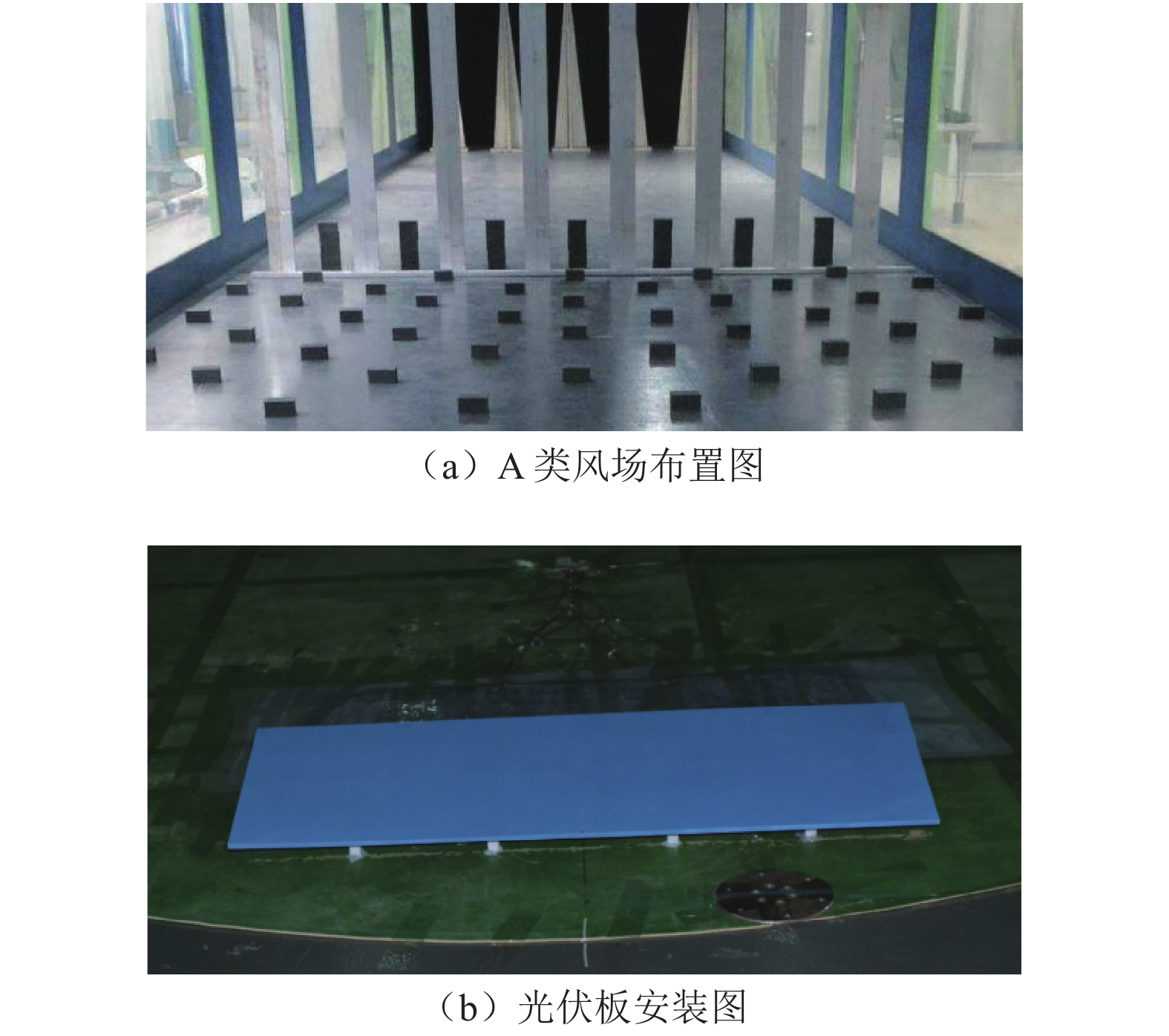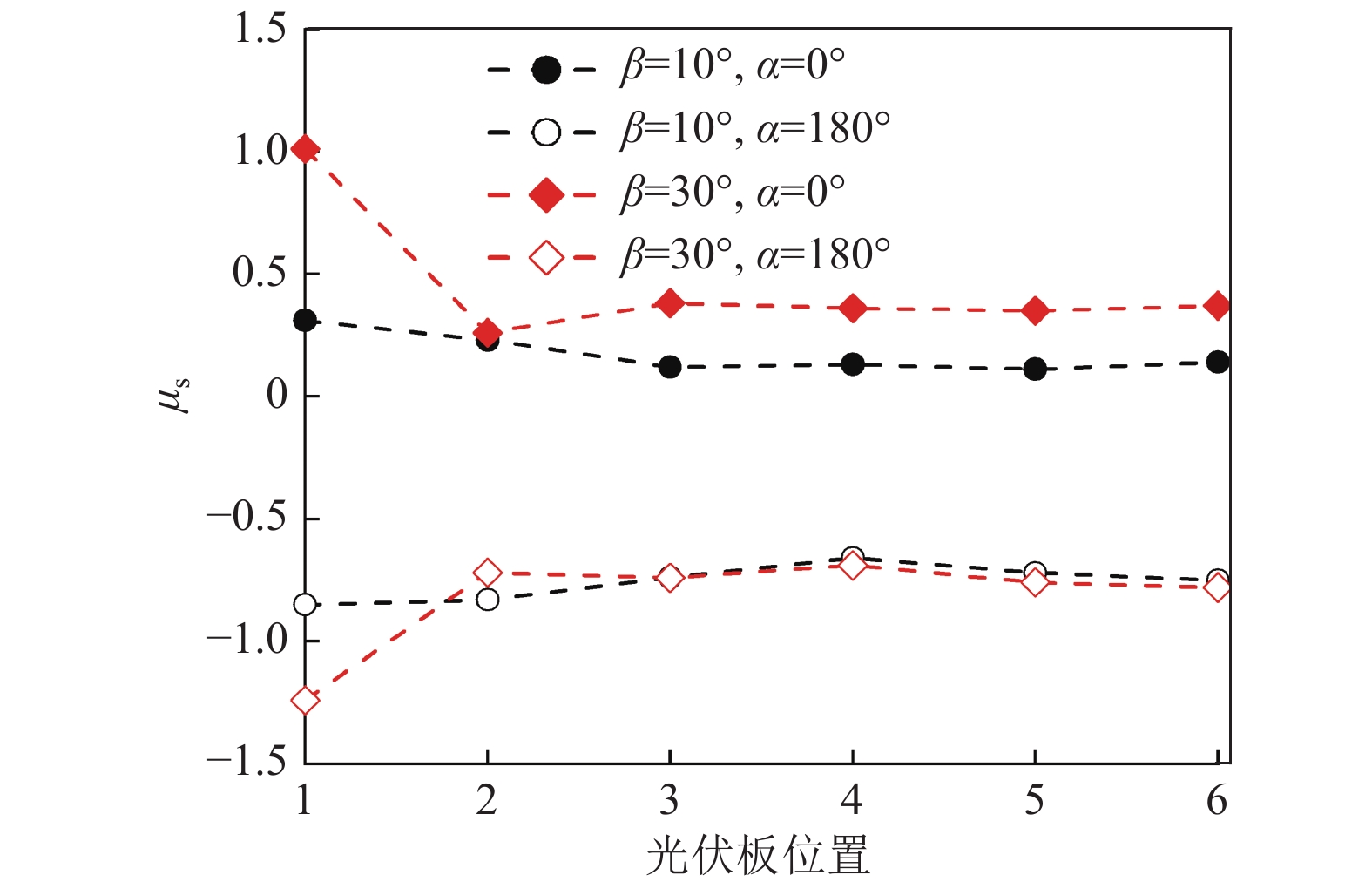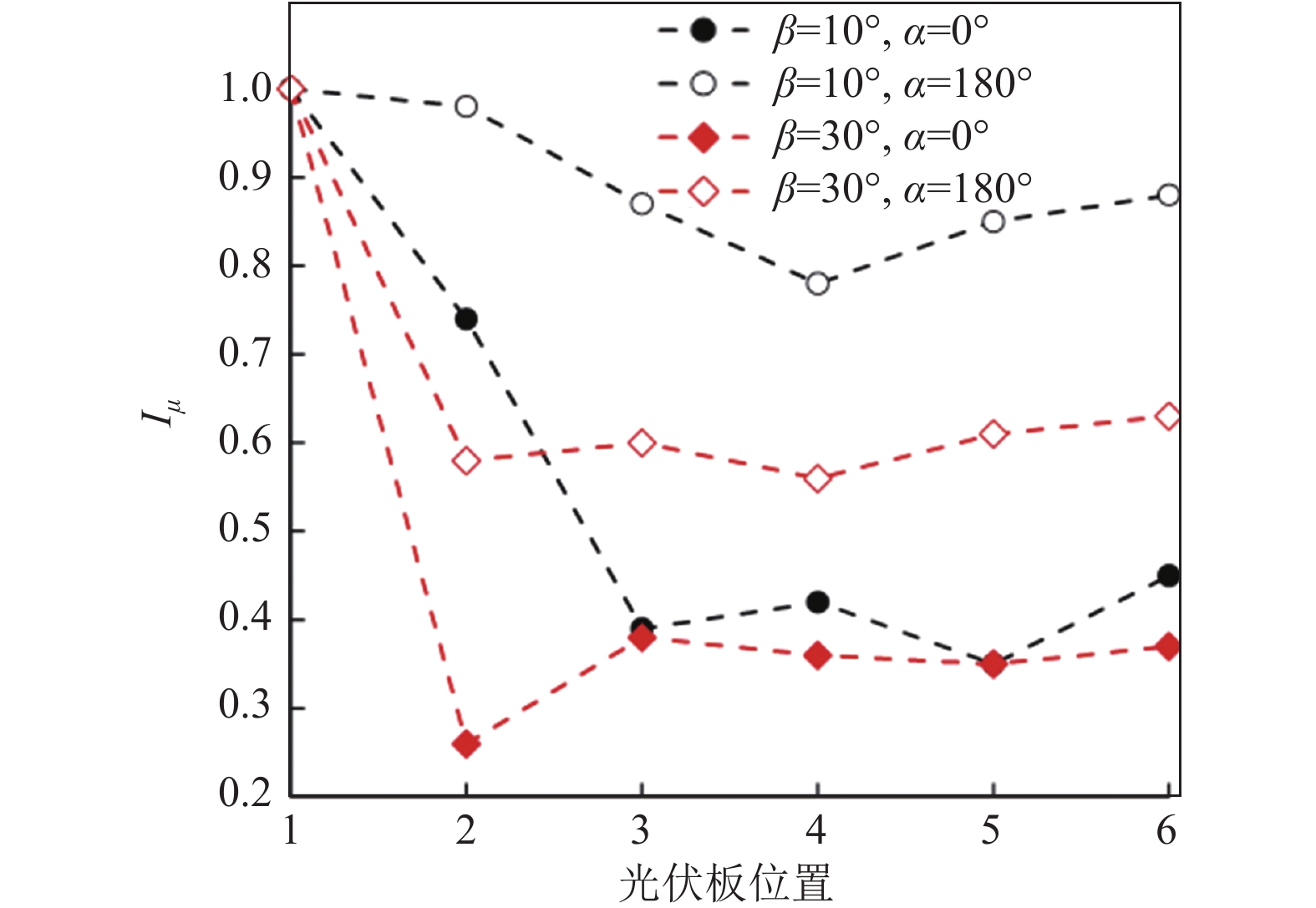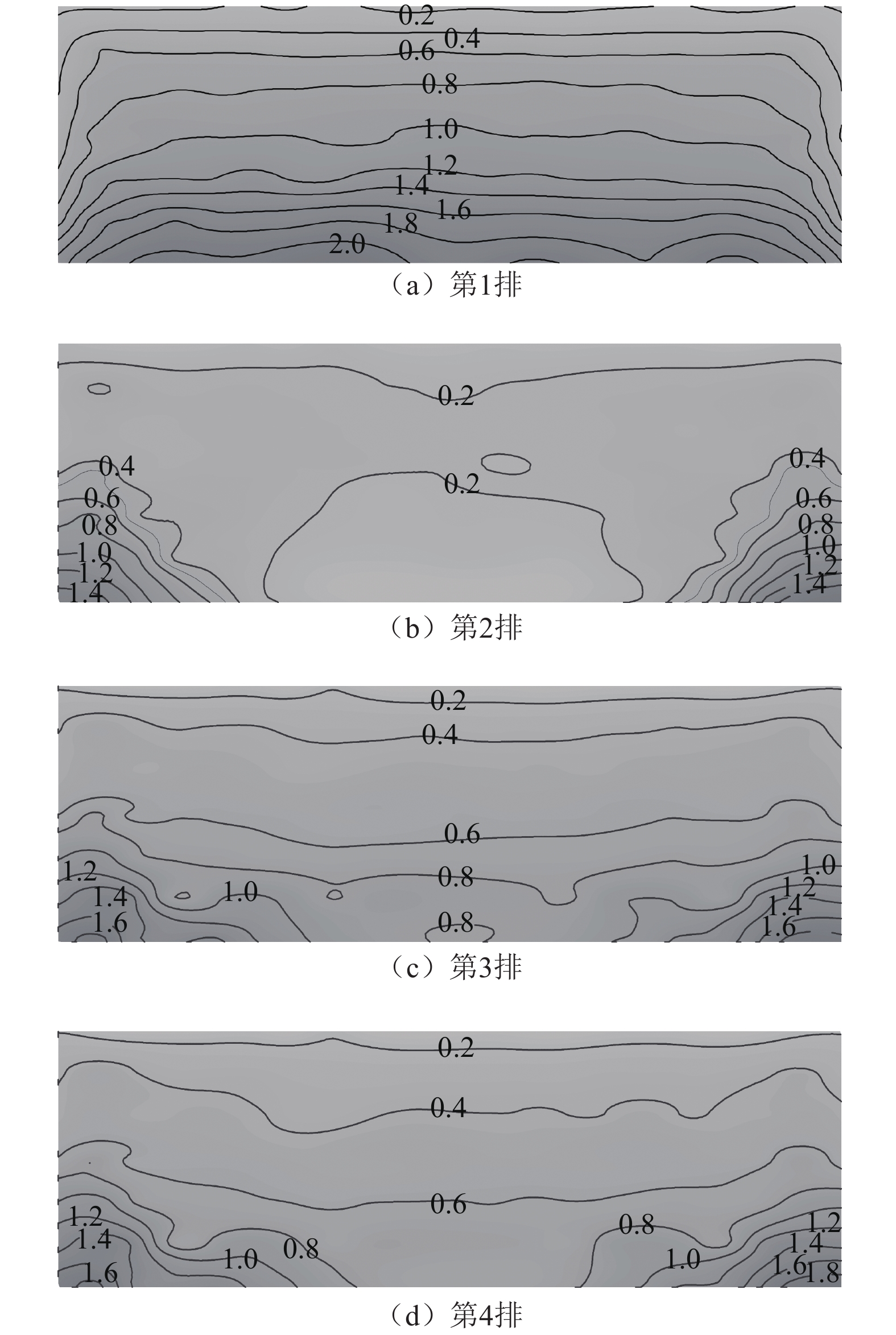Wind tunnel experimental study on the wind load interference effect of solar panel arrays
-
摘要: 风荷载是光伏板设计的主要荷载,对于大面积光伏阵列,其风致干扰效应明显,风荷载取值需要进一步研究明确。本文采用刚性模型测压风洞试验研究了光伏板体型系数干扰效应。通过改变倾角、风向角和光伏板的组数,研究了阵列中干扰效应对光伏板风荷载取值的影响。结果表明:当光伏板面迎风或者背风时,出现最大正压或负压;上游光伏板对下游光伏板存在明显的遮挡效应,倾角越大,遮挡效应越显著;上游光伏板三排以后,下游光伏板的风荷载趋于稳定。基于上述干扰效应给出了光伏阵列体型系数的取值建议并与规范取值进行了对比,为光伏阵列的抗风设计提供参考。Abstract: Wind load is one of the main concerns in the design of the solar panel. The wind-induced interference effect is significant in the solar panel array, which needs further investigation. Pressures on the rigid solar panel models were measured in a wind tunnel to study the interference effect of solar panels on their pressure coefficients. By changing the inclination angle, wind direction and the number of solar panels, the interference effect on the wind load on the panels is studied. The results show that the most unfavorable wind load occurs when the panel is orientated to the wind. The upstream panels obviously shield the downstream ones and reduce their wind load. This shielding effect becomes more significant with the increase of the inclination angle. The wind load on the downstream panel tends to be constant when it locates downstream three or more panel rows. Based on the above interference effect, the pressure coefficients on the solar panel arrays are recommended and compared with those in standards, which provides a reference for the wind-resistant design of the solar panel supporting system.
-
Keywords:
- solar panel array /
- wind tunnel test /
- pressure coefficient /
- interference effect
-
-
表 1 光伏板体型系数试验值与规范值对比
Table 1 Comparison between the test value and the standard value of the solar panel pressure coefficient

体型系数 试验值 光伏支架结构
设计规程β=10° μs1 0.35 0.80 μs2 –0.90 –0.95 β=30° μs1 1.10 1.00 μs2 –1.35 –1.30 
体型系数 ASCE 7-10 AS/NZS 1170 β=10° μs1 1.67 0.67 μs2 0.40 0.27 μs3 –1.57 –0.77 μs4 0.00 –0.53 β=30° μs1 2.60 1.60 μs2 1.00 0.80 μs3 –2.50 –2.20 μs4 –0.50 –1.10 -
[1] 光伏支架结构设计规程: NB/T 10115-2018[S]. 北京: 中国计划出版社, 2018. Code for design of photovoltaic modules support structures: NB/T 10115-2018[S]. Beijing: China Planning Press, 2018.
[2] 张庆祝,刘志璋,齐晓慧,等. 太阳能光伏板风载的载荷分析[J]. 能源技术,2010,31(2):93-95. ZHANG Q Z,LIU Z Z,QI X H,et al. Solar photovoltaic panels wind load testing and analysis[J]. Energy Technology,2010,31(2):93-95.
[3] 何惧,朱锐,王建勃. 光伏电池板风荷载数值模拟计算[J]. 太阳能,2013(16):56-58. DOI: 10.3969/j.issn.1003-0417.2013.16.018 HE J,ZHU R,WANG J B. Numerical simulation of wind load of photovoltaic panels[J]. Solar Energy,2013(16):56-58. doi: 10.3969/j.issn.1003-0417.2013.16.018
[4] AGARWAL A,IRTAZA H,ZAMEEL A. Numerical study of lift and drag coefficients on a ground-mounted photo-voltaic solar panel[J]. Materials Today: Proceedings,2017,4(9):9822-9827. doi: 10.1016/j.matpr.2017.06.274
[5] SHADEMAN M,BALACHANDAR R,BARRON R M. Detached eddy simulation of flow past an isolated inclined solar panel[J]. Journal of Fluids and Structures,2014,50:217-230. doi: 10.1016/j.jfluidstructs.2014.06.024
[6] 马文勇,孙高健,刘小兵,等. 太阳能光伏板风荷载分布模型试验研究[J]. 振动与冲击,2017,36(7):8-13. DOI: 10.13465/j.cnki.Jvs.2017.07.002 MA W Y,SUN G J,LIU X B,et al. Tests for wind load distribution model of solar panels[J]. Journal of Vibration and Shock,2017,36(7):8-13. doi: 10.13465/j.cnki.Jvs.2017.07.002
[7] 马文勇,柴晓兵,刘庆宽,等. 底部阻塞对太阳能光伏板风荷载的影响研究[J]. 建筑结构,2019,49(2):129-134. MA W Y,CHAI X B,LIU Q K,et al. Study on effect of bottom flow obstruction on wind load of solar photovoltaic panels[J]. Building Structure,2019,49(2):129-134.
[8] 李寿科,李寿英,陈政清. 太阳电池板风荷载试验研究[J]. 太阳能学报,2015,36(8):1884-1889. DOI: 10.3969/j.issn.0254-0096.2015.08.015 LI S K,LI S Y,CHEN Z Q. Experimental investigation of wind loading of solar panels[J]. Acta Energiae Solaris Sinica,2015,36(8):1884-1889. doi: 10.3969/j.issn.0254-0096.2015.08.015
[9] JUBAYER C M,HANGAN H. Numerical simulation of wind effects on a stand-alone ground mounted photovoltaic (PV) system[J]. Journal of Wind Engineering and Industrial Aerodynamics,2014,134:56-64. doi: 10.1016/j.jweia.2014.08.008
[10] 高亮,窦珍珍,白桦,等. 光伏组件风荷载影响因素分析[J]. 太阳能学报,2016,37(8):1931-1937. DOI: 10.3969/j.issn.0254-0096.2016.08.005 GAO L,DOU Z Z,BAI H,et al. Analysis of influence factors for wind lode of pv module[J]. Acta Energiae Solaris Sinica,2016,37(8):1931-1937. doi: 10.3969/j.issn.0254-0096.2016.08.005
[11] 江继波,章正暘,陆元明,等. 考虑弯矩的光伏阵列风荷载数值分析[J]. 可再生能源,2019,37(1):46-52. DOI: 10.13941/j.cnki.21-1469/tk.2019.01.008 JIANG J B,ZHANG Z Y,LU Y M,et al. Numerical analysis of wind loads about photovoltaic arrays considering bending moment[J]. Renewable Energy Resources,2019,37(1):46-52. doi: 10.13941/j.cnki.21-1469/tk.2019.01.008
[12] JUBAYER C M,HANGAN H. A numerical approach to the investigation of wind loading on an array of ground mounted solar photovoltaic (PV) panels[J]. Journal of Wind Engineering and Industrial Aerodynamics,2016,153:60-70. doi: 10.1016/j.jweia.2016.03.009
[13] WARSIDO W P,BITSUAMLAK G T,BARATA J,et al. Influence of spacing parameters on the wind loading of solar array[J]. Journal of Fluids and Structures,2014,48:295-315. doi: 10.1016/j.jfluidstructs.2014.03.005
[14] 中华人民共和国住房和城乡建设部. 中华人民共和国国家标准: 建筑结构荷载规范 GB 50009—2012[S]. 北京: 中国建筑工业出版社, 2012. Ministry of Housing and Urban-Rural Development of the People's Republic of China. National Standard (Mandatory) of the People's Republic of China: Load code for the design of building structures. GB 50009—2012[S]. Beijing: China Architecture & Building Press, 2012.
[15] 韩晓乐. 太阳能光伏阵列风荷载取值研究[D]. 石家庄: 石家庄铁道大学, 2016. HAN X L. Study on wind load of solar photovoltaic array[D]. Shijiazhuang: Shijiazhuang Tiedao University, 2016.
[16] Minimum Design Loads for Buildings and Other Structures: ASCE Standard ASCE/SEI 7-10[S]. Virginia: American Society of Civil Engineers, 2010.
[17] Structural Design Actions: Australian/New Zealand Standard AS/NZS 1170[S]. Wellington: Standards Australia International Ltd, 2002.







 下载:
下载:









